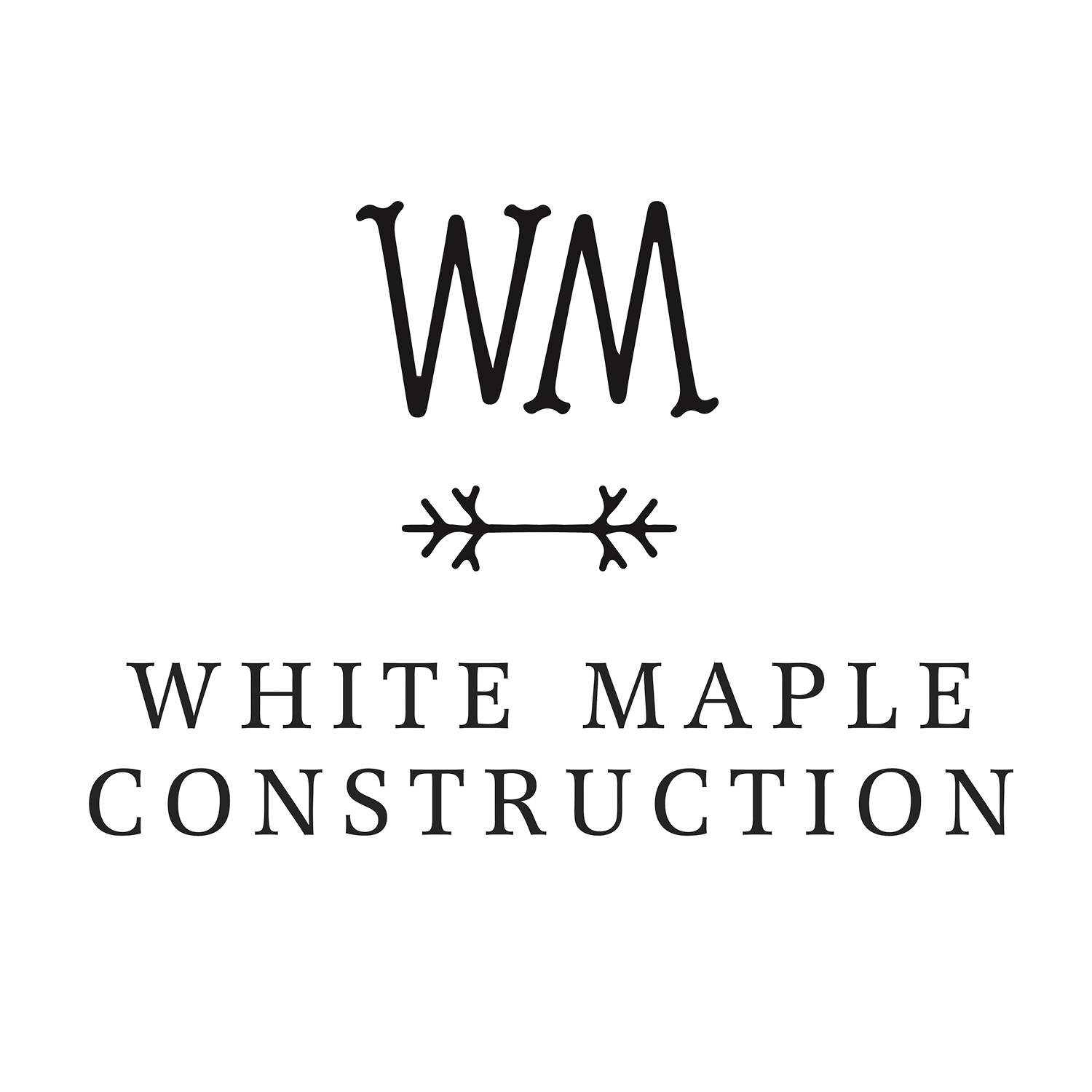Financing
At White Maple Construction, we know that building or remodeling a home is about more than design and construction, it’s about making the process accessible from start to finish. That’s why we guide our clients through financing options with the same care and attention we bring to every detail of a project. From tapping into existing equity to exploring creative lending solutions, we help remove the barriers so your dream of a custom home or whole home renovation can move forward with confidence.
Custom Home & Remodeling Financing Options
Our Lenders
Being a design-build firm means we can handle every aspect of your project from concept to completion, including getting the designs made and managing through to construction, reducing stress and ensuring a cohesive outcome. If you already have designs made, it’s no worry; we can work with those too.

Financing Options
Construction Loan
Process:
- You purchase the land and lock in your interest rate from day one.
- The construction loan acts as a line of credit, with funds disbursed as construction progresses.
- Monthly inspections determine the value of completed work, and the bank releases funds accordingly.
- Once construction is complete, the loan converts to an amortized mortgage.
Pros:
- Interest Rate Lock: You lock in your interest rate at the beginning, providing financial predictability.
- Lower Taxes: Property taxes during construction are based on the land value, typically lower than the completed home.
Cons:
- Qualification: Construction loans require greater cash reserves, typically 20-30% of the home’s value.
- Complexity: The process is more cumbersome, involving regular inspections and fund disbursements based on construction milestones.
Home Equity Loan
A home equity loan allows you to borrow against the equity you’ve built in your existing home. You receive a lump sum payment upfront, which you repay with fixed monthly installments over a set term—typically 10 to 30 years.
Process:
- The bank appraises your home to determine your available equity.
- You borrow a lump sum based on a percentage of that equity.
- You begin making fixed monthly payments immediately.
Pros:
- Predictable Payments: Fixed interest rates and monthly payments make budgeting easier.
- Lower Rates: Typically lower than credit cards or personal loans.
- Tax Benefits: Interest may be tax deductible if used for home improvements (consult your tax advisor).
Cons:
- Less Flexibility: Once you take the lump sum, you can’t borrow additional funds without reapplying.
- Home as Collateral: Defaulting puts your property at risk.
- Equity Requirement: You generally need at least 15–20% equity to qualify.
Home Equity Line of Credit (HELOC)
A HELOC functions like a credit card secured by your home’s equity, giving you flexibility to borrow funds as needed up to an approved limit. It’s divided into two periods: the draw period, when you can access funds, and the repayment period, when you repay principal and interest.
Process:
- Your lender determines available credit based on your home’s appraised value and remaining mortgage balance.
- You can draw funds as needed during the draw period (usually 10 years).
- Monthly payments are based on the amount borrowed and the current variable interest rate.
Pros:
- Flexibility: Borrow only what you need, when you need it.
- Interest Savings: Pay interest only on the funds you draw.
- Revolving Credit: As you repay, the credit becomes available again.
Cons:
- Variable Rates: Payments can increase as interest rates fluctuate.
- Shorter Terms: Draw periods are limited, requiring repayment sooner.
- Equity Risk: Your home still secures the loan, so missed payments can have serious consequences.
Cash-Out Refinance
A cash-out refinance replaces your current mortgage with a new one that has a higher balance—providing cash based on the equity you’ve built. This allows you to consolidate your renovation costs into a single monthly mortgage payment.
Process:
- Your lender appraises your home to calculate available equity.
- You refinance your existing mortgage for more than you currently owe.
- The difference between the new and old loan amounts is paid to you in cash.
Pros:
- Single Payment: Combines your mortgage and project financing into one monthly payment.
- Potentially Lower Rates: May reduce your overall mortgage rate if current rates are favorable.
- Large Funding Capacity: Ideal for full remodels or large-scale projects.
Cons:
- Closing Costs: Refinancing incurs fees similar to a new mortgage.
- Longer Loan Term: Extends your repayment period, possibly increasing total interest paid.
- Market Dependence: If current interest rates are higher than your existing mortgage, this option may cost more long-term.
End Loan
An end loan is the simplest and most straightforward way to finance a new home. Here’s how it works:
Process:
- You choose your new home.
- An appraisal is conducted, and your documents are reviewed to ensure you qualify.
- You set a closing date and make a down payment (typically 10-20%).
- The bank provides the remaining mortgage amount, and you receive the keys at closing.
Pros:
- Simplicity: The process is straightforward, with only one transaction at closing.
- Ease: You know the terms and conditions upfront, making it easier to plan.
- Direct Sale: Property taxes are assessed based on the purchase price, which simplifies tax calculations.
Cons:
- Interest Rate Lock: You lock in your interest rate close to the closing date, which could be months after starting construction. This means you might face higher rates if market conditions change.
- Higher Taxes: Taxes are based on the full purchase price of the home.
Alternative Options
Apart from these conventional loans, there are several other alternatives you can explore, such as:
- Securing a personal loan or credit line
- Tapping into retirement funds or personal investments
- Selling another property or home
- Seeking financial assistance from family and friends
- Acquiring private money loans
- And additional options
Custom Home & Remodeling Financing Options
Financing Options
Construction Loan
Process:
- You purchase the land and lock in your interest rate from day one.
- The construction loan acts as a line of credit, with funds disbursed as construction progresses.
- Monthly inspections determine the value of completed work, and the bank releases funds accordingly.
- Once construction is complete, the loan converts to an amortized mortgage.
Pros:
- Interest Rate Lock: You lock in your interest rate at the beginning, providing financial predictability.
- Lower Taxes: Property taxes during construction are based on the land value, typically lower than the completed home.
Cons:
- Qualification: Construction loans require greater cash reserves, typically 20-30% of the home’s value.
- Complexity: The process is more cumbersome, involving regular inspections and fund disbursements based on construction milestones.
Home Equity Loan
A home equity loan allows you to borrow against the equity you’ve built in your existing home. You receive a lump sum payment upfront, which you repay with fixed monthly installments over a set term—typically 10 to 30 years.
Process:
- The bank appraises your home to determine your available equity.
- You borrow a lump sum based on a percentage of that equity.
- You begin making fixed monthly payments immediately.
Pros:
- Predictable Payments: Fixed interest rates and monthly payments make budgeting easier.
- Lower Rates: Typically lower than credit cards or personal loans.
- Tax Benefits: Interest may be tax deductible if used for home improvements (consult your tax advisor).
Cons:
- Less Flexibility: Once you take the lump sum, you can’t borrow additional funds without reapplying.
- Home as Collateral: Defaulting puts your property at risk.
- Equity Requirement: You generally need at least 15–20% equity to qualify.
Home Equity Line of Credit (HELOC)
A HELOC functions like a credit card secured by your home’s equity, giving you flexibility to borrow funds as needed up to an approved limit. It’s divided into two periods: the draw period, when you can access funds, and the repayment period, when you repay principal and interest.
Process:
- Your lender determines available credit based on your home’s appraised value and remaining mortgage balance.
- You can draw funds as needed during the draw period (usually 10 years).
- Monthly payments are based on the amount borrowed and the current variable interest rate.
Pros:
- Flexibility: Borrow only what you need, when you need it.
- Interest Savings: Pay interest only on the funds you draw.
- Revolving Credit: As you repay, the credit becomes available again.
Cons:
- Variable Rates: Payments can increase as interest rates fluctuate.
- Shorter Terms: Draw periods are limited, requiring repayment sooner.
- Equity Risk: Your home still secures the loan, so missed payments can have serious consequences.
Cash-Out Refinance
A cash-out refinance replaces your current mortgage with a new one that has a higher balance—providing cash based on the equity you’ve built. This allows you to consolidate your renovation costs into a single monthly mortgage payment.
Process:
- Your lender appraises your home to calculate available equity.
- You refinance your existing mortgage for more than you currently owe.
- The difference between the new and old loan amounts is paid to you in cash.
Pros:
- Single Payment: Combines your mortgage and project financing into one monthly payment.
- Potentially Lower Rates: May reduce your overall mortgage rate if current rates are favorable.
- Large Funding Capacity: Ideal for full remodels or large-scale projects.
Cons:
- Closing Costs: Refinancing incurs fees similar to a new mortgage.
- Longer Loan Term: Extends your repayment period, possibly increasing total interest paid.
- Market Dependence: If current interest rates are higher than your existing mortgage, this option may cost more long-term.
End Loan
An end loan is the simplest and most straightforward way to finance a new home. Here’s how it works:
Process:
- You choose your new home.
- An appraisal is conducted, and your documents are reviewed to ensure you qualify.
- You set a closing date and make a down payment (typically 10-20%).
- The bank provides the remaining mortgage amount, and you receive the keys at closing.
Pros:
- Simplicity: The process is straightforward, with only one transaction at closing.
- Ease: You know the terms and conditions upfront, making it easier to plan.
- Direct Sale: Property taxes are assessed based on the purchase price, which simplifies tax calculations.
Cons:
- Interest Rate Lock: You lock in your interest rate close to the closing date, which could be months after starting construction. This means you might face higher rates if market conditions change.
- Higher Taxes: Taxes are based on the full purchase price of the home.
Alternative Options
Apart from these conventional loans, there are several other alternatives you can explore, such as:
- Securing a personal loan or credit line
- Tapping into retirement funds or personal investments
- Selling another property or home
- Seeking financial assistance from family and friends
- Acquiring private money loans
- And additional options
Our Lenders
Being a design-build firm means we can handle every aspect of your project from concept to completion, including getting the designs made and managing through to construction, reducing stress and ensuring a cohesive outcome. If you already have designs made, it’s no worry; we can work with those too.



